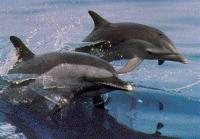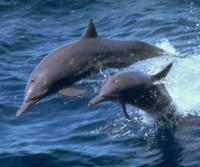 |
|
Genus Stenella
The genus Stenella includes five of the most acrobatic species of small cetaceans. All have distinct beaks and either a spotted or striped coloration. Most of the species have vibrant colors, ranging from white to blue to dark gray. They are extrememly active at the surface of the water, making their schools highly conspicuous. Many species frequently school with tuna, causing problems with the eastern tropical Pacific tuna purse seine fishery. All have distributions that surround the equator, some extending into temperate waters. | ||||
 Distribution Map
Distribution Map(Click for larger version) |
The pantropical spotted dolphin, sometimes called simply the spotted dolphin or spotter, has a distribution in all of the world's tropical waters and some subtropical areas. There is significant geographical variation, but all forms are small and slender, and most have a prominent spotted pigmentation, consisting of light colored spots on the darker dorsal area and dark spots on the lighter ventral area. All have a "cape" coloration, similar to but more pronounced than the bottlenose dolphin. Specimens may be recognized by the white-tipped beak present on adults, although the white coloration is not as pronounced in the eastern Pacific stocks. The behavior is typical of the genus, being very active at the surface. Frequent breaching and long jumping are seen. The pantropical spotted dolphin is the fastest swimmer that has been accurately timed, able to reach 40 kilometers per hour over short distances. It frequently associates with the yellowfin tuna and long-snouted spinner dolphins, causing it to play a large part in the eastern tropical Pacific tuna purse seine fishery. | ||||
 Distribution Map
Distribution Map(Click for larger version) |
The clymene dolphin, also known as the short-snouted spinner dolphin, is the least known of the genus Stenella. In the mid-twentieth century, there was almost no litterature on it, and very little is known to this date. Over time, various cetologists have integrated it with other species, and only as recently as 1981 was it recognized officially as a separate species. The overall appearance is similar to that of the long-snouted spinner dolphin, but the snout is much shorter. It has three stripes of color: a dark gray dorsal side, a white ventral side, and a mid tone sandwiched in between running down each flank. Very little is known of the behavior in the wild. Although it has been seen spinning in the same manner as its long-snouted cousin, the jumps aren't nearly as high or complex. In one photograph, it was riding a bow wave. Unlike the long-snouted spinner dolphin, there are no known threats to its survival, as it is not involved in the tuna purse seine fishery. | ||||
 Distribution Map
Distribution Map(Click for larger version) |
The striped dolphin is found offshore, in most of the world's tropical, subtropical, and warm temperate waters. It is best known from Japanese waters, although also common in the Mediterranean and Red Seas. Due to its coloration, it is sometimes called the blue-white dolphin, which is the meaning of the name coeruleoalba. Most descriptions of the species emphasize the blue coloration and the stripes. The dorsal surface is dark blue, while the ventral surface is white. The dark stripes trail from the eyes on each flank to the anal region along the main plimsoll line. In most cases, the upper part of the beak is dark while the ventral part is lighter, but not entirely white. Although known since 2000 BC, it is still considered an enigma to taxonomists, as there is much geographical variation and debate about speciation. Some individuals have double stripes rather than single stripes, leading some taxonomists to propose two separate species: S. coeruleoalba and S. styx. The most recent classifications give only one species. It makes up a very small part of the eastern tropical Pacific tuna purse seine fishery, on the order of less than 1%. The most significant threat is in the waters of Japan, where it is hunted locally for food. | ||||
 Distribution Map
Distribution Map(Click for larger version) |
The Atlantic spotted dolphin, sometimes known as the gulfstream spotted dolphin or the long-snouted spotted dolphin is a medium-sized species found only in the Atlantic Ocean. It's exact range is poorly known because it is not commonly found near coastal waters, except that is it seen seasonally near Florida. It is believed to range in the western North Atlantic from Cape May, New Jersey to Panama. In appearance this dolphin is very similar to the pantropical spotted dolphin. It would be easily distinguishable except that the pantropical spotted dolphin is sometimes seen in the range of the Atlantic spotted dolphin. In general, although the distinction is not quite clear, the Atlantic spotted dolphin has more spots and is more robust. Newborn specimens are unspotted, and closely resemble bottlenose dolphins, leading to many incorrect reports of mixed schools. The Atlantic spotted dolphin is one of the few species where the appearance of the young differs so significantly from that of the adults. In most species, the young differ from the adults only in size and color. The spots are not seen well at a distance, so schools not seen up close may be confused with schools of bottlenose dolphins. The bottlenose dolphin, however, is larger, has a stocker build, and has a proportionally shorter snout. In adults, the spots grow larger, forming blotches. There do not appear to be any records of the blotches merging to form a uniform color, as has been suggested. The spots probably serve partially as an interspecies recognition device and partially as camouflage against such species as killer whales. Specimens are often found in sparkling, white-capped waves, which are common in an open-sea environment. Atlantic Spotted Dolphins are playful and curious, but at the same time timid. When hearing the commotion of a ship, they will race to it from miles away and play alongside for several miles. They are also fast swimmers, having little trouble keeping up with a boat traveling at more than 50 kilometers per hour. However, because they are so timid, they must be kept in a tank separate from the bottlenose dolphin, which is domineering and terretorial. Normally groups are very large, although some reports of solitary individuals have surfaced. It is fortunate that so much information has been collected on this species without the need for the slaughter of millions of individuals as has occured with many of its close relatives. | ||||
 Distribution Map
Distribution Map(Click for larger version) |
The spinner dolphin, also called the long-snouted spinner dolphin, is one of the primary species involved in the eastern tropical Pacific tuna purse-seine fishery. This slaughter has put the species under scrutiny, leading to much study. It has a range almost identical to that of the pantropical spotted dolphin, in all of the world's tropical waters and some subtropical and temperate waters. Physical appearance may vary significantly, but there are three main forms: the eastern Pacific form, which is dark gray all over except for a white patch on the belly, the whitebelly form, which is dark gray on the dorsal side, blue-gray on the flanks, and white on the ventral side, and the Hawaiian form, which resembles the whitebelly form except that it is darker, the flanks are more gray, and the white-colored area is larger. The spinner is probably the most acrobatic dolphin around. Its name stems from the fact that when breaching, it spins up to seven times on its long axis in a most spectacular sight. It frequently associates with other cetaceans and with the yellowfin tuna in the eastern tropical Pacific. | ||||
|
BibliographyBaker, Mary L. Whales, Dolphins, and Porpoises of the World. New York: Doubleday & Company, Inc., 1987. Carwardine, Mark. Eyewitness Handbooks: Whales, Dolphins, and Porpoises. New York: Dorling Kindersley Ltd., 1995. Ellis, Richard. Dolphins and Porpoises. New York: Alfred & Knopf, Inc., 1982. Klinowska, Margaret. Dolpins, Porpoises, and Whales of the World: The IUCN Red Data Book. Gland, Switzerland: World Conservation Union, 1991. |
|
© 1998 Thinkquest Team 17963 <17963@advanced.org Modified: 29 August 1998, Created: 8 August 1998 |

 A couple of Clymene Dolphins
A couple of Clymene Dolphins
 A Couple of Spinner Dolphins
A Couple of Spinner Dolphins